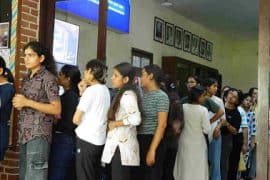University of Delhi will be conducting its Joint Admission Test for BMS/BBA(FIA) and BA(Hons.) Business Economics on Sunday, 20th June 2016.
The exam is only the first stage of the admission process where its weightage is 45% along with 40% weightage given to the 12th Board scores and 7.5% given to both the interview and group discussion round. Read more about the seat breakup and other crucial details from our previous report here.
According to the Admission Brochure given by DU, –
– The exam will have 120 questions to be attempted in 120 minutes
– Each question will be objective type multiple choice based.
– The exam will be take place from 3PM TO 5PM 6th June 2016.
– Each correct answer will get the candidate 3 marks and every incorrect answer will get them 1 negative mark.
– The question paper will be divided into 4 sections.
Here is a detailed section-wise guide I have made based on my experience of giving 2014 JAT –
1. Quantitative Ability
This section will contain questions from the 11th and 12th Maths syllabi. Questions from the 12th class Math syllabus won’t be that challenging, although you might want to brush up on Relations and Functions as many people skip it as it doesn’t have much weightage in the board exams, 5 questions are expected to be coming from Relations and Functions.
3-D Geometry is another unit you might want to prepare as it might contain 4-5 questions.
From the 11th Class syllabus, Sets and Permutations and Combinations are important units to be covered. Probability is a unit which spans both the 11th and 12th syllabi, therefore it is expected to be a major part of the Quantitative Ability section. Questions involving dice and deck of cards are expected to come.
2. Reasoning and Analytical Ability
This section will include reasoning and assertion based questions. It is also expected to contain a subsection of either a bar graph or chart and 8-10 questions based on analysis of that graph. Any data interpretation book will help you to practice questions which might appear in this section.
3. General English
This section’s name might make you think that it will be easy to attempt but it might prove to be the toughest for many people.
It will contain a reading comprehension subsection containing at least 5 questions which is considerably easy to attempt and does not need much preparation. 5 questions are expected to be idiom-based so learning basic English idioms may help. 5 direct vocabulary questions are also expected. For the vocabulary questions, research previous year papers and other exams (for example: CLAT) and identify and learn important words from there, this is the best shot to score in vocabulary as mugging up hundreds of words at this point will not benefit you. Fill in the blanks and one word substitution are also expected to come and are considerably easy and do not require practice.
4. Business and General Awareness
This section will contain direct general knowledge based questions. Since this section does not require much thinking, do not give too much time attempting it.
The main feature of General Awareness is that most of it contains ‘static general knowledge’ based questions. Popular questions in this section are along the lines of product and their companies. Start memorizing what product is produced by which company (your shampoo bottle,your shoes, clothes etc) and taglines of products and companies. Memorize what banks are nationalized and important international days (Eg: Women’s day, Earth Day, AIDS Awareness Day)
Look up where popular companies’ headquarters are located, memorize important international and national prize winners of the current and previous years (eg: Nobel Prize, Bharat Ratna)
Some other helpful tips-
– Attempt the General Awareness and English section first as they require lesser thinking than the other two sections, this will give you more time to devote to the time consuming math problems. Be careful of the question numbering in the OMR sheet, though.
– I personally recommend you NOT to wild guess. Other exams generally have a 4:1 ratio of positive and negative marking however this exam has a 3:1 ratio so you have more to lose.
– A very repetitive tip but if you’re stuck on a question, leave it. It will be a challenge to attempt 120 questions in 120 minutes, utilize the time carefully.
All the best!




Comments are closed.